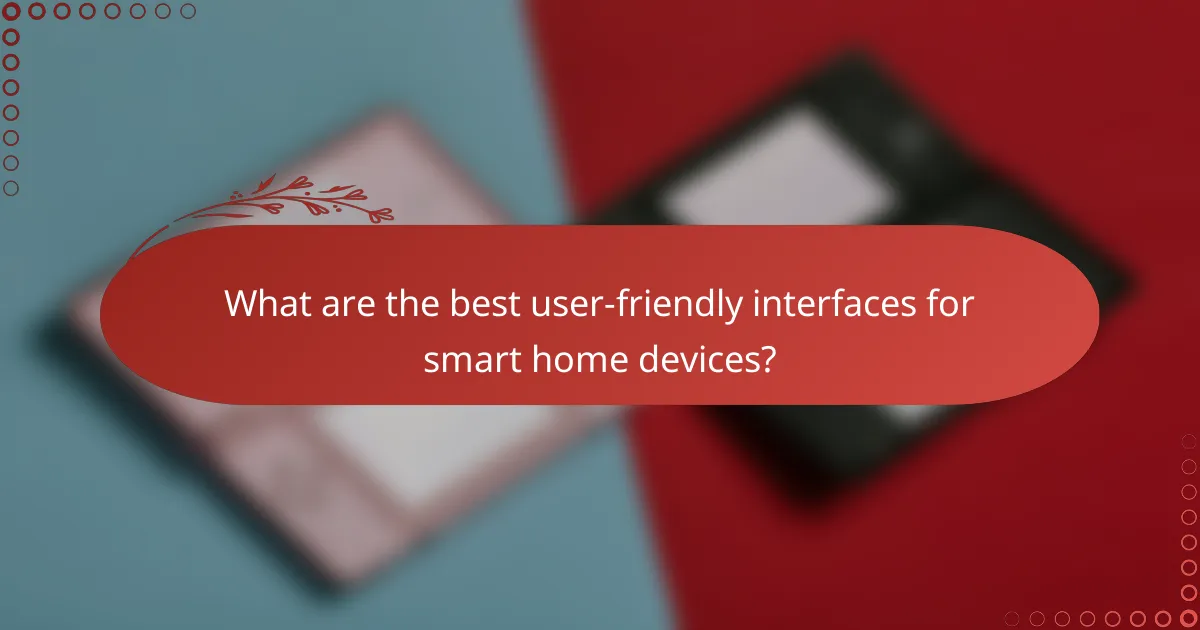User-friendly interfaces are essential for enhancing the experience of smart home devices, focusing on simplicity and intuitive navigation. Effective controls and well-organized menus play a crucial role in enabling users to interact with technology seamlessly, ensuring that customization and operation are efficient and straightforward.

What are the best user-friendly interfaces for smart home devices?
The best user-friendly interfaces for smart home devices prioritize simplicity, intuitive navigation, and seamless integration with various smart home ecosystems. Devices like the Google Nest Hub, Amazon Echo Show, Apple HomePod mini, and Samsung SmartThings stand out for their ease of use and accessibility.
Google Nest Hub
The Google Nest Hub features a touchscreen interface that allows users to control smart home devices with simple taps and voice commands. Its integration with Google Assistant makes it easy to access information, manage schedules, and control compatible devices through voice recognition.
Consider using the Nest Hub for its visual feedback, which can display information like weather updates, calendars, and photo slideshows. The setup process is straightforward, typically requiring just a few minutes to connect to Wi-Fi and link devices.
Amazon Echo Show
The Amazon Echo Show combines Alexa’s voice capabilities with a vibrant display, making it user-friendly for controlling smart home devices. Users can issue voice commands or use the touchscreen to manage devices, view security camera feeds, and make video calls.
When setting up the Echo Show, ensure it is placed in a central location for optimal voice recognition. The device supports a wide range of smart home products, so check compatibility before purchasing additional devices.
Apple HomePod mini
The Apple HomePod mini offers a sleek design and is integrated with Siri, making it easy to control smart home devices using voice commands. Its interface is minimalistic, focusing on voice interaction rather than a visual display.
For Apple users, the HomePod mini seamlessly integrates with the Apple Home app, allowing for straightforward setup and control of compatible devices. Keep in mind that it works best within the Apple ecosystem, so consider this if you use other Apple products.
Samsung SmartThings
Samsung SmartThings provides a comprehensive app-based interface for managing a variety of smart home devices. The platform supports numerous brands and allows users to create custom automations and routines.
Setting up SmartThings involves downloading the app and connecting devices through a straightforward process. Be aware that while it offers extensive compatibility, some devices may require additional configuration for optimal performance.

How do controls impact user experience in software applications?
Controls significantly influence user experience by determining how easily users can interact with software applications. Well-designed controls enhance usability, allowing users to navigate, customize, and operate the software efficiently.
Intuitive navigation
Intuitive navigation is crucial for a positive user experience, as it allows users to find what they need without confusion. Effective navigation structures often include clear labels, logical groupings, and consistent layouts. For instance, using familiar icons and a straightforward menu hierarchy can help users locate features quickly.
To optimize navigation, consider implementing breadcrumb trails and search functionality. These tools can guide users back to previous sections or help them find specific content rapidly. Avoid cluttering the interface with too many options, as this can overwhelm users and hinder their ability to navigate effectively.
Customizable settings
Customizable settings empower users to tailor software applications to their preferences, enhancing their overall experience. Allowing adjustments such as theme selection, layout preferences, and shortcut keys can make the software more user-friendly. For example, enabling users to choose between a light or dark mode can improve comfort during prolonged use.
When designing customizable features, ensure they are easy to access and modify. Providing a simple interface for adjustments encourages users to explore options without feeling intimidated. Additionally, consider offering preset configurations for different user types, which can streamline the setup process for new users while still accommodating advanced users seeking more control.

What are the key features of effective menu designs?
Effective menu designs prioritize user experience by ensuring clarity, organization, and adaptability. Key features include clear labeling, logical grouping of items, and responsive design that accommodates various devices and screen sizes.
Clear labeling
Clear labeling is essential for effective menu designs as it helps users quickly understand their options. Labels should be concise and descriptive, using familiar terminology that aligns with user expectations. For example, instead of using technical jargon, opt for straightforward terms like “Home,” “About Us,” and “Contact.”
To enhance clarity, consider using icons alongside text labels. This visual aid can help users quickly identify functions, especially in complex menus. Regularly testing labels with real users can also provide insights into their effectiveness.
Logical grouping
Logical grouping organizes menu items into categories that make sense to users, improving navigation efficiency. Group related items together, such as placing all product categories under a single “Products” menu. This structure allows users to find what they need without unnecessary clicks.
When designing groups, consider user behavior and common tasks. For instance, if users frequently look for support, placing “Help” or “Support” at the top level can enhance accessibility. Aim for no more than five to seven items in each group to avoid overwhelming users.
Responsive design
Responsive design ensures that menus function seamlessly across different devices, from desktops to smartphones. A well-designed responsive menu adapts its layout and functionality based on screen size, maintaining usability regardless of the device. For example, a horizontal menu may transform into a collapsible dropdown on smaller screens.
To implement responsive design, use flexible grid layouts and media queries. Testing menus on various devices is crucial to identify any usability issues. Prioritize touch-friendly elements for mobile users, ensuring that buttons are large enough to tap easily without errors.

How can setup ease affect product adoption?
Setup ease significantly influences product adoption by reducing initial friction for users. A straightforward setup process encourages users to engage with the product quickly, leading to higher retention rates and satisfaction.
Quick start guides
Quick start guides provide users with essential information to begin using a product immediately. These guides typically include basic setup instructions, key features, and troubleshooting tips, all presented in a concise format.
To create effective quick start guides, focus on clarity and brevity. Use bullet points for key steps, and include visuals where possible to enhance understanding. For example, a guide might outline three simple steps to connect a device to Wi-Fi, making it easier for users to get started.
Step-by-step wizards
Step-by-step wizards guide users through the setup process in a structured manner. These interactive tools break down complex tasks into manageable steps, allowing users to complete each phase before moving on to the next.
When designing a step-by-step wizard, ensure that each step is clear and provides feedback. For instance, a wizard for software installation might include progress indicators and tips for common issues, helping users feel more confident throughout the process.

What criteria should be used to evaluate user-friendly interfaces?
To evaluate user-friendly interfaces, consider criteria such as accessibility, intuitiveness, and responsiveness. These factors ensure that users can navigate and interact with the interface efficiently and comfortably.
Accessibility standards
Accessibility standards are essential for creating user-friendly interfaces that accommodate all users, including those with disabilities. Common guidelines include the Web Content Accessibility Guidelines (WCAG), which outline how to make web content more accessible to people with various disabilities.
When evaluating an interface, check for features like keyboard navigation, screen reader compatibility, and color contrast. Implementing these standards can significantly enhance usability for a broader audience, ensuring compliance with regulations in many regions.
User feedback mechanisms
User feedback mechanisms are vital for understanding how real users interact with an interface. Incorporating tools such as surveys, usability tests, and analytics can provide insights into user behavior and preferences.
To effectively gather feedback, consider using simple rating systems or open-ended questions after key interactions. Regularly reviewing this feedback helps identify pain points and areas for improvement, ultimately leading to a more user-friendly experience.

What are the emerging trends in user interface design?
Emerging trends in user interface design focus on enhancing user experience through intuitive controls, streamlined menus, and simplified setup processes. These trends prioritize accessibility, personalization, and the integration of advanced technologies like AI and voice recognition.
Minimalist Design
Minimalist design emphasizes simplicity and functionality, reducing clutter to enhance user focus. This trend often involves using ample white space, limited color palettes, and straightforward navigation. Users benefit from quicker decision-making as they are presented with only essential elements.
For example, many modern applications feature a single-page layout that allows users to access all necessary functions without overwhelming them with choices. This approach can significantly improve user satisfaction and retention rates.
Voice User Interfaces (VUIs)
Voice user interfaces are gaining traction as they provide hands-free interaction, making technology more accessible. VUIs allow users to control devices and applications using natural language, which can be particularly beneficial for individuals with disabilities or those multitasking.
Incorporating VUIs requires careful consideration of language processing capabilities and user intent recognition. Brands like Amazon and Google have successfully integrated voice commands into their ecosystems, enhancing user engagement and convenience.
Personalization and Customization
Personalization in user interfaces allows users to tailor their experience according to their preferences, leading to increased satisfaction. This trend includes customizable dashboards, themes, and content recommendations based on user behavior and interests.
For instance, streaming services often analyze viewing habits to suggest relevant content, creating a more engaging experience. However, designers must balance personalization with privacy concerns, ensuring that user data is handled securely.
Responsive and Adaptive Design
Responsive and adaptive design ensures that interfaces function seamlessly across various devices and screen sizes. This trend is crucial as users increasingly access applications on smartphones, tablets, and desktops.
Responsive design adjusts layout and content dynamically, while adaptive design uses predefined layouts for specific devices. Both approaches aim to provide a consistent and user-friendly experience, regardless of the platform.
Augmented Reality (AR) and Virtual Reality (VR)
AR and VR technologies are transforming user interfaces by creating immersive experiences. These technologies allow users to interact with digital elements in a real-world context or within a fully virtual environment.
Applications in retail, education, and gaming are leading the way, offering users engaging ways to visualize products or learn new skills. However, the complexity of developing AR and VR interfaces requires careful planning to ensure usability and accessibility.










